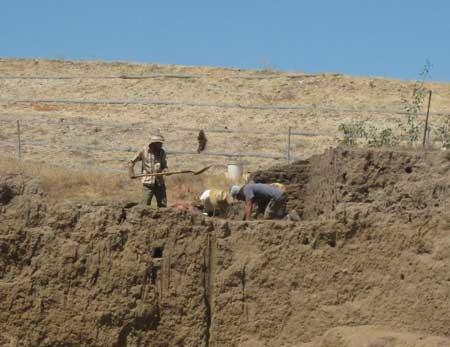Blake DePastino
Source - http://westerndigs.org/severed-heads-skull-bowls-found-in-california-graves-were-tributes-not-war-trophies-study-finds/
A 3,000 year-old village discovered in central California has been found to contain an unusual set of burials — with more than a half dozen individuals buried without their heads, and nearly as many others buried intact, with an extra skull by their side.
In two of the graves, the crowns of the severed skulls had even been fashioned into smooth, polished bowls.
 A digitized images shows the position of Burial 137, an adult male who was over 40 years of age at the time of death. A modified calotte, or skull cap, was found next to the skull, and may have been placed in his left hand at the time of interment. Like the other calotte found at the site, this artifact had rounded and highly polished edges, and may have been used as a small bowl. (Photo courtesy Eerkens et al.)
A digitized images shows the position of Burial 137, an adult male who was over 40 years of age at the time of death. A modified calotte, or skull cap, was found next to the skull, and may have been placed in his left hand at the time of interment. Like the other calotte found at the site, this artifact had rounded and highly polished edges, and may have been used as a small bowl. (Photo courtesy Eerkens et al.)
But despite this eerie tableau, these decapitations are not signs of violence or war, archaeologists say.
Instead, analysis of the remains shows that they may be evidence of an ancient method of paying tribute to ancestors — possibly even a way of re-uniting family members after death.
“In our own society, we sometimes keep the ashes of our ancestors in a vase on our mantle, or keep photographs of them to remind us,” said Dr. Jelmer Eerkens, an anthropologist at the University of California at Davis, who led the study of the remains.
“But in some societies, they kept the bones of their ancestors.”
The village was first uncovered in 2002, during the construction of a development project near the town of Brentwood, about 70 kilometers [45 miles] east of Oakland on the banks of a small stream known as Marsh Creek.
A large-scale archaeological excavation followed, revealing the remnants of cooking fires, sites for making food and tools, and nearly 500 human burials.
Some artifacts dated back more than 7,000 years, but radiocarbon dates from more than 130 of the burials returned dates ranging from 3,000 to 4,000 years ago.
The Marsh Creek site provided a rare view into the lives of California’s sedentary hunter-gatherers, people who lived in small settlements and subsisted on acorns, seeds, fish, and small game.
But the most salient feature of the village was its unusual graves.
In seven of the burials — two of men, two of women, and three of indeterminate sex — the remains had no heads.
And eight other graves — four of men, two of women, and two indeterminate — contained a complete skeleton, with an additional skull buried alongside it.
And among those burials, two of men in their late 30s or early 40s, also included an unusual artifact: the top of a human skull that had been meticulously polished into a small, smooth bowl shape. One of these skull crowns — called calottes — was made from the head of an adolescent, and had been daubed with red ochre.
What purpose these artifacts served is unclear, Eerkens said, but the removal of skulls found in the Marsh Creek graves is not entirely unique.
“Such burials are not common, but are certainly not unheard of in other parts of California,” Eerkens said.
“Extra skulls and individuals missing their skull are found once in a while. There are also many examples of people buried missing arms and/or legs.”
“It’s the context that is important for figuring out if such activities are the byproduct of violence, or are part of ritual or other activities,” he said.
Previous research in California has turned up evidence of head-taking and scalping, and ethnographic accounts have shown that, in some native societies, trophy heads were displayed as warnings to would-be interlopers.
As a result, when the Marsh Creek burials were first uncovered, some archaeologists chalked up the severed heads to prehistoric warfare, with the victors having taken the heads of the vanquished as a kind of grim spoils of war.
“Interpretations were being made about these items, either skull cap bowls or extra skulls that were buried with people, that they were trophies from victims of warfare,” Eerkens said.
“This would imply that the skulls were from people who were not living at the site, but lived elsewhere.”
 The Marsh Creek village and its burials were uncovered in 2002, during the construction of a development project near the town of Brentwood. (Photo courtesy Eerkens et al.)
The Marsh Creek village and its burials were uncovered in 2002, during the construction of a development project near the town of Brentwood. (Photo courtesy Eerkens et al.)
So Eerkens and his colleagues set out to test this theory, by analyzing the chemistry of the Marsh Creek remains.
They sampled teeth and bone from nearly 200 individuals, in search of isotopes of strontium — which can tell scientists where a person was born and raised — as well as nitrogen, which can provide clues about the person’s diet.
Strontium is an element that occurs naturally in groundwater and has different forms, or isotopes. But those isotopes show up in different concentrations, depending on the local geology.
When we drink water, or we eat animals that drink the same water, those specific concentrations become fixed in our teeth and bones. So anthropologists can study the strontium in human remains to determine where a subject lived — especially during childhood, as their teeth were forming.
PART.2